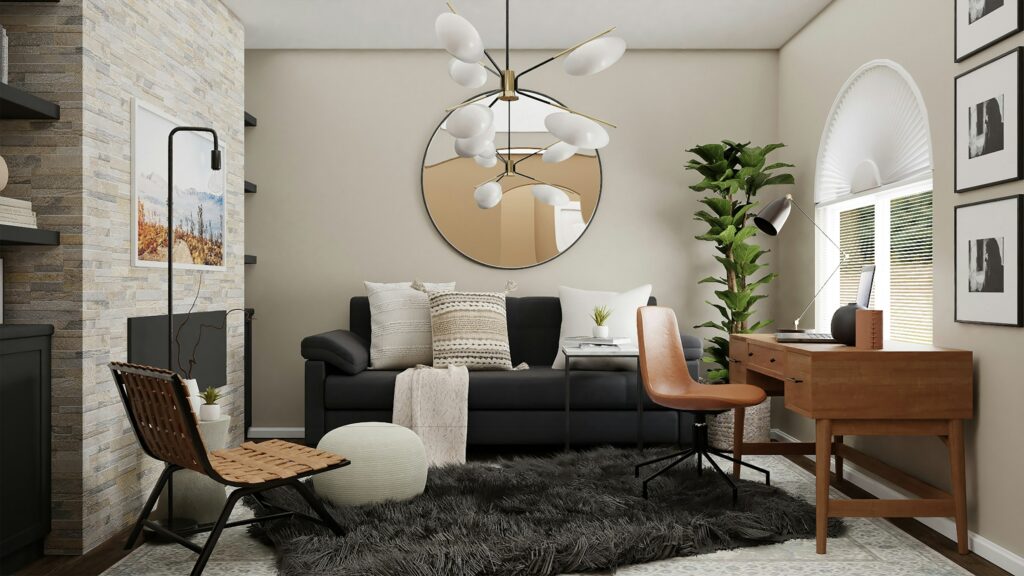
More individuals are choosing smaller living—in an urban apartment, a comfortable studio, or a downsized house—in the fast-paced environment of today. Living tiny does not imply, however, abandoning utility or design. Any little room may be turned into a fashionable, multifunctional place fit for your lifestyle with the correct home décor ideas and creative design techniques.
Welcome to Minimal Space, Maximum Impact—your all-around manual on multifarious space design that combines form with utility. Whether you work from home, have visitors, or just unwind, your space should serve all purposes—without clutter.
1. Embrace the Power of Zones
Any well-designed multipurpose space is mostly dependent on well-defined functional “zones” inside one area. Plot your demands first: a dining nook, a work area, and a lounging zone, for instance. Without walls, visually define these spaces using furniture placement, lighting, and carpets.
A pendant lamp over a small dining table might highlight the eating area; a soft rug can ground your living space. Even a tall bookcase may be a chic room divider providing one-sided storage and isolation.
2. Opt for Multifunctional Furniture
Every piece of furniture has to be economical, given limited space. Search for dual-use products such as:
- A couch bed for visitors
- Storage ottomans that function as chairs
- Drop-leaf tables for dining or office space.
- A console desk that, when not in use, folds against the wall.
In any little house, furniture that transforms changes everything. It allows you to adjust your environment depending on your demands during the day; this is a necessary feature of contemporary house and life.
3. Go Vertical with Storage
Think instead of spreading out. Maximize space without overpowering the room by using vertical storage options. At the same time, liberating floor space, tall bookshelves, wall-mounted cabinets, floating shelves, and hanging organizers keep your basics handy.
This is particularly crucial in places like the bedroom or kitchen, where utility rules. Stylish storage options that double as décor include woven baskets, translucent acrylic boxes, or ornamental boxes, which help to hide your goods.
4. Choose a Cohesive Color Palette
A small area feels wide and harmonic in great part from color. To achieve visual flow, choose a limited, neutral palette with some accent colors. Good basic colors that optically enlarge the area are soft whites, beiges, subdued grays, and warm taupes.
Without adding clutter, add personality with paintings, plants, toss pillows, or metallic finishes in brass or gold—touches that fit your overall home décor concepts.
5. Use Mirrors to Reflect Light and Space
One of the first moves in the small-space styling book—and for good reason—is mirrors. A big mirror on the wall can deceive the eye into seeing more space than there is, bounce light throughout the room, and raise the ceiling feel-through.
To increase impact, set a mirror near a light source or across a window. For the best style, use a chic frame that accentuates your current furniture.
6. Create a Portable Workstation
Many people find they require a specific workspace—without the luxury of a separate office—as remote work becomes the standard. The answer is a portable or little desk.
A neat writing desk or fold-out table will fit against a wall or in a corner rather quickly. Coordinate it with a chic chair fit for workplace work as well as dining. Store items within reach with a wall-mounted pegboard or vertical file organizer. Just clean and take back the space for other use when off the clock.
See our Home and Living area for chic ideas and more clever, real-life design guidance.
7. Make Use of DIY Home Tips
Sometimes, homemade inventiveness is the best place to find space solutions. Some concepts to motivate your upcoming work:
- Floating desks from salvaged wood or nightstands on floats
- Under-bed storage drawers, including wheels for seasonal goods
- Magnetic spice shelves hung on the refrigerator’s side.
- For modular wall storage, vivid colored pegboards
Without a large budget or makeover, these DIY home tips will let you give your room individualized use and style.
8. Lighting Is Everything
Particularly in multipurpose rooms, layered lighting improves mood and use. Rather than depending only on one overhead light, combine:
- Task lighting—akin to desk lamps—comes first.
- Floor lamps and string lights, ambient lighting
- LED strips behind shelves for accent lighting
Like dimmers or app-activated bulbs, smart lighting controls let you tap to go between work mode and leisure. In areas that serve several purposes all day, this adaptability is really essential.
9. Think Minimal, Not Empty
Minimalism is about having only what serves you, not about having less. Select deliberately beautiful, useful, and elegant objects. Clear extra from your area and concentrate on what improves your daily life.
This method simplifies cleaning and arranging and keeps your multipurpose room aesthetically quiet and emotionally uplifting—a refuge where you may work, relax, and entertain with simplicity.
Final Thoughts
Designing a multipurpose room presents more than simply a design challenge; it’s a chance to show your originality and let your space work harder and look better. Your house will feel roomy and modern, especially yours, by combining smart storage, multifunctional furniture, a consistent color palette, and a few do-it-yourself home ideas.
Looking for more inspiration? For more well-chosen home décor ideas, trends, and useful advice, visit Glamor & Living’s Home and Living section.




